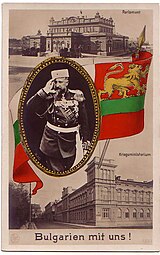Battle of Bazargic
 From Wikipedia the free encyclopedia
From Wikipedia the free encyclopedia
| Battle of Bazargic | |||||||
|---|---|---|---|---|---|---|---|
| Part of the Dobruja Campaign of the Romanian Campaign of World War I | |||||||
 Map of the Romanian campaign | |||||||
| |||||||
| Belligerents | |||||||
| Central Powers: | Allied Powers: | ||||||
| Commanders and leaders | |||||||
| | | ||||||
| Strength | |||||||
| 23 battalions,10 artillery batteries, 17 cavalry squadrons | 46 battalions,17 artillery batteries,19 cavalry squadrons | ||||||
| Casualties and losses | |||||||
| 1,053 killed 2,324 wounded[2] | Unknown | ||||||
The Battle of Bazargic, also known as the Battle of Dobrich or the Dobrich epopee (Bulgarian: Добричка епопея), took place between 5 and 7 September 1916 between a joint Bulgarian–German force, consisting mainly of the Bulgarian Third Army, and a Romanian–Russian force, including a Division of Serbian Volunteers serving under the Russian 47th Corps. The battle was part of the Romanian campaign towards the end of 1916.[3] It ended with a Central Powers victory.
Background[edit]
Although bound by the pre-war Triple Alliance to the Central Powers, Romania instead joined the Triple Entente in August 1916, following the signing of the Treaty of Bucharest (1916). German Commander Field Marshal August von Mackensen was put in charge of the Romanian campaign in the Dobruja front. In September the 3rd Bulgarian Army was reinforced with two Ottoman divisions and part of a German division. The Central Powers' plan was to attack the Romanian forces in Transylvania, while at the same time attacking along the Black Sea, into the Dobruja, a region inhabited mainly by Bulgarians and assigned to Romania in 1913,[3] as a result of the Second Balkan War and the ensuing Treaty of Bucharest (1913).
Battle[edit]
Mackensen started with a surprise move on Turtucaia, a Romanian fortress. Although the besieging force was smaller than the garrison, most surrendered quickly to the Bulgarian 3rd Army after their commander fled.[4]
Along with German reinforcements, Bulgarian units on the Southern front who crossed the border and invaded the Dobruja found themselves facing the Romanian Third Army and two Russian infantry divisions. Some of the Romanian units had surrendered to the Russians, believing them to be Bulgarians.[5]
Simultaneously with the assault of the fortress of Turtucaia, the Bulgarian Third Army defeated the Romanian-Russian force, including the First Serbian Volunteer Division, at the Battle of Bazargic, despite their numerical superiority.[6] The outnumbered forces of the Central Powers managed to push the Romanians and the Russians north, while the Serbian Volunteer division suffered heavy casualties with 8,539 dead and wounded.[7]
On 7 September after intense fighting the defeated Russian general ordered a withdrawal.[8]

Aftermath[edit]
As the Romanian army withdrew into Moldavia by the beginning of November, the Central Powers had captured the whole of Dobruja.[9]
Notes[edit]
- ^ General Stefan Toshev 1921 “The activity of the 3rd Army in Dobrudja in 1916”, p.68; Действията на III армия в Добруджа 1916, стр. 68
- ^ Симеонов, Радослав, Величка Михайлова и Донка Василева. Добричката епопея. Историко-библиографски справочник, Добрич 2006, с. 181.
- ^ a b Norman Stone 2008, p. 712–713.
- ^ Norman Stone 2008, p. 712-713.
- ^ Holger H. Herwig 2014, p. 213.
- ^ Симеонов, Радослав, Величка Михайлова и Донка Василева. Добричката епопея. Историко-библиографски справочник, Добрич 2006
- ^ Ivo Banac 2015, p. 121–123.
- ^ Richard C. Hall 2010, p. 70-71.
- ^ Norman Stone 2008, p. 720.
References[edit]
- Norman Stone (2008). The Eastern Front 1914-1917. Penguin Books Limited. ISBN 978-0-14-193885-1.
- Richard C. Hall (2010). Balkan Breakthrough: The Battle of Dobro Pole 1918. Indiana University Press. ISBN 978-0-253-00411-6.
- Ivo Banac (2015). The National Question in Yugoslavia: Origins, History, Politics. Cornell University Press. ISBN 978-1-5017-0193-1.
- Holger H. Herwig (24 April 2014). The First World War: Germany and Austria-Hungary 1914-1918. A&C Black. ISBN 978-1-4725-1081-5.
- Българската армия в Първата световна война 1915-1918: Кратък енцикл. справ (in Bulgarian). Св. Георги Победоносец. 1939.
External links[edit]

